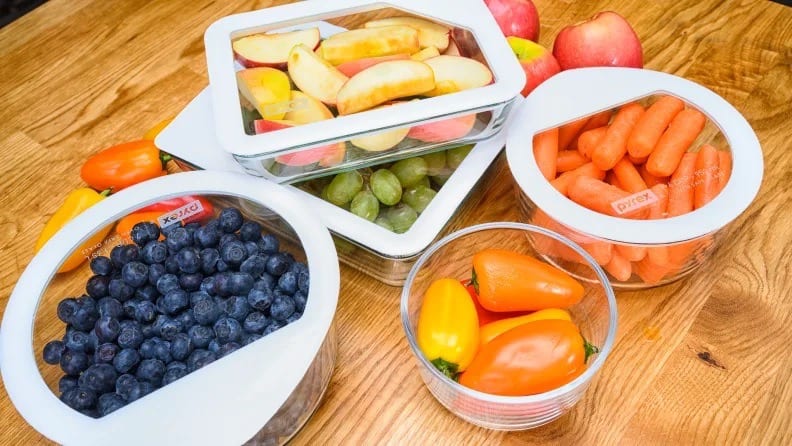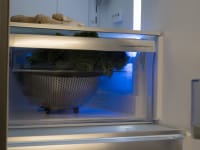Here's how long your leftovers are really safe to eat
Step away from the week-old pizza
Products are chosen independently by our editors. Purchases made through our links may earn us a commission.
Did you grow up in a family where wasting food was one thing you just didn't do? Whatever was left on the dinner table was packed away, stacked neatly in the fridge, then consumed over the next few days until every last bit was gone. Where nothing went in the trash unless there was visible mold (and even then, sometimes your mom would just cut mold off bread or cheese and deem it "fine")?
While saving leftovers is a great way to minimize food waste and ultimately save money, you also want to make sure you're not taking any health risks. So how long are leftovers good for, really?
Here's what the experts have to say—and how you can store your food to help it stay fresher for longer.
How long are leftovers good for?
How long your leftovers will last depends on how they're stored, of course. According to the USDA, any perishable food left out at room temperature for more than two hours (or for more than an hour if the ambient temperature is above 90°F) should be tossed immediately.
When it comes to refrigerated leftovers, the USDA says for most food it's best to eat it within three to four days to be safe. And the FDA lays out similar guidance, with a strict four-day maximum for most leftovers. But certain foods hold better than others under these conditions, according to Reviewed's Chief Scientist Dave Ellerby.
"Pickles and preserves use acidity and high sugar levels to create unfriendly conditions for bacterial growth," Ellerby explains. "So logically, acidic or sugary foods (like salsa or pies) should also have some resistance to bacterial growth. In these cases, consuming them within the longer end of the FDA limit should be fine."
He also explains that where your food is stored is just as important as how long you store it.
"Fridges don't stop food from spoiling; they buy you some time by slowing down how quickly bacteria grow on the food. But that's only true if your fridge is at the right temperature," Ellerby says. "If you're serious about keeping your food in good shape, you should invest in a refrigerator thermometer and make sure your fridge is at 40°F or slightly below, and that your freezer is at 0°F."
Ultimately, if you're concerned, Ellerby recommends being conservative and following the FDA guidelines. "Even if food looks and smells okay, it could still potentially contain harmful bacteria."
How to store leftovers properly in the fridge

The best food storage containers we tested were the Pyrex Ultimate.
You can have the best refrigerator in the world set at the perfect temperature, but if you don't have the right containers, your leftovers are doomed.
Our kitchen and cooking team recommends sturdy, glass containers that stack easily in the fridge, from brands like Pyrex or Glasslock.
Another easy way to keep your food fresh is to keep your fridge clean. Spoiled food can release ethylene gas and bacteria, which will then speed up the spoilage of surrounding foods.
Plus, regularly cleaning your refrigerator helps you keep track of what you have so you don't forget about the leftover spaghetti hiding in the back corner.
You'll also want to make sure you're making good use of your fridge's crisper drawers. Keep an eye on settings and separate your low-humidity foods from your high-humidity foods to make sure you're making the most out of each produce haul.
How (and when) to freeze leftovers
We always recommend freezing food, especially if it's raw meat or something that you made a lot of and don't want to eat for days on end. While the quality of meat will eventually degrade in the freezer, it's much safer than putting it in the fridge and hoping for the best. Freezing food is especially great when it comes to soups, stews, curries, and liquid-based meals, because they can easily be reheated.
Freezing loaves of bread in individual slices is also an easy way to minimize waste. Just make sure to store any sliced loaf in a freezer-safe sealable bag to avoid freezer burn. Then, all it calls for is a pop in the toaster oven when you're ready for a slice.
The key with freezing food (just as with storing leftovers in the fridge) is to use containers with airtight seals to protect against freezer burn, dehydration, and losing any inherent flavor and texture from your food.
Our favorite tool for storing food in airtight packages is the FoodSaver Vacuum Sealer Machine, ranked as the best vacuum sealer during our testing procedure at the Reviewed labs. This machine is easy to use and works well when storing everything from raw proteins to fresh produce. It might be an investment up front, but can save you hundreds on well-stored groceries for years to come.



